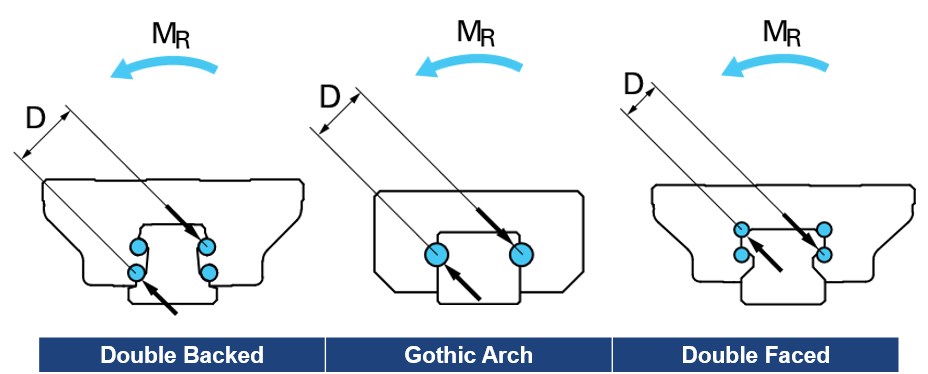Design and Theory
Types of profile rail ball track configurations
In profile rail there are three basic track layouts:
- Double backed
- Gothic arch
- Double faced
These three different layouts are shown in the drawing below. The greater the distance "D" between the bearings
the better the unit is at resisting roll moments. Notice that the distance "D" for the same sized rail is greatest for the double backed (left) and is
the smallest for the double faced (right). Therefore, the double
backed would have the highest roll moment rating, while the double
faced would have the lowest. With the Gothic arch somewhere in between.
Double backed
For applications that require extremely high location accuracy or moment resistance, double-backed profile rails are usually the optimal choice. However, the rigidity of the double-backed design also decreases the allowable installation tolerances, increasing surface preparation costs. Double-backed designs are unable to tolerate even minor misalignment so mounting surface preparation and proper installation are critical for proper operation and long life. If the mounting surface is not prepared properly, the guide will run rough and need to be replaced more frequently than normal. Small flatness errors in mounting surfaces can reduce bearing life by up to 50%. More severe alignment issues can result in immediate failures. Typical applications include machine tools, semiconductor manufacturing, circuit board assembly, and high accuracy machine axis applications.Double faced
Double-faced ball track bearing arrangements utilize a 45 degree, face-to-face bearing arrangement to provide equal load carrying capacity in all directions. Double-faced profiles have a lower resistance to moment loads because the vectors resisting the moment load are closer to the center of rotation. The primary advantage of the double-faced configuration is that the rails are much more tolerant of mounting surface inaccuracies. This enables machine builders to reduce system costs by not having to prepare mounting surfaces for ultra-high precision. Mounting surface preparation and installation are still important to providing long life, but double-faced designs tend to be more forgiving. For applications that do not require extremely high location accuracy or moment resistance, double-faced profile rails are often the optimal choice. Double-faced profile rails also tend to have a lower initial cost. Typical applications include factory automation, packaging, material transfer, medical sample handling, and moderate accuracy machine axis applications.Additional Reading
For more on the benefits and draw backs of each design read the article "Picking the right linear rails for your application" linked here.



